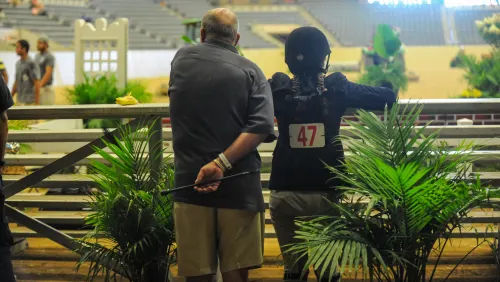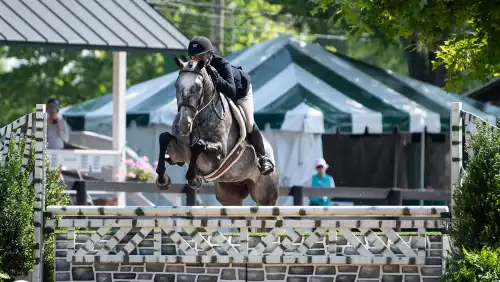Long after the other international riders had changed into their street clothes, the German team, still in their red coats and sporting the Samsung Super League winners’ sashes, held court in the local hotel’s traditional pub in Dublin, Ireland.
Led by Ulrich Kirchhoff and Heinz Heinrich Engemann, glasses held high and singing German songs, they had reason to celebrate: they’d posted two of the six double-clear performances on the day to win the Samsung Super League Nations Cup at the Dublin CSIO, Aug. 9-13.
With the win in the last leg of the series before the final in Barcelona on Sept. 15, the Germans widened their lead in the overall standings, with 45.125 points over the United States in second with 36 points, followed closely by France at 34 points.
The U.S. team’s fourth place proved their gritty determination to stay within fighting distance of defending their Super League title at the final.
Fighting To The Finish
At the end of Round 1, the United States and France were tied for fourth with 8 faults. Anne Kursinski and Roxana 112 and Molly Ashe on Neuville had one rail apiece. Candice King and Coco Cabana had the drop score (14 faults) when the mare reacted to the noisy stadium. Christine McCrea jumped last on Vegas and posted a clear.
The first round ended with Germany and the Netherlands tied at the top of the leader board with 0 faults. Ireland was a single rail behind at 4 faults, as Shane Breen on World Cruise kept the fans happy with a clear performance.
In Round 2, it seemed that the United States had no chance of breaking into the battle for the podium between Germany, the Netherlands, and the home team of Ireland. So, they concentrated on staving off a French take-over for fourth.
Kursinski posted a second-round clear, as King improved on her first-round score, dropping only the liverpool oxer, but adding a time fault. Ashe almost duplicated her first score of a single rail but also added a time penalty. And McCrea had the front rail of 11B but hustled around to stay within the time. They finished with 17 faults.
ADVERTISEMENT
France doubled their initial eight-fault team total when Pierre Jarry faulted twice. Jacques Bonnet’s stallion, Gracieux Ardent HN–who was eliminated in Round 1–again didn’t make it past the second fence. Though Stephan Lafouge was pleased with his small chestnut Gabelou Des Ores’ double-clear performance, disappointment was evident in a 24-fault, fifth place team result.
The real Super League battle isn’t about who can catch the Germans, but instead who will avoid elimination at the season’s end. The last-placed team in the series is relegated to the regular Nations Cup circuit, replaced by the winners of that series.
Ireland desperately needed a strong finish before the packed stadium of a loyal home crowd. While they rallied, placing third–their best result all year–it still wasn’t good enough, and they remain last heading for the final.
Sitting just ahead of Ireland on the perilous penultimate bottom rung before the Dublin Nation’s Cup, the Netherlands also felt the pressure. Two of their riders managed double-clear rounds (Jeroen Dubbledam on BMC Up And Down and Piet Raymakers with Van Schijndel’s Curtis) to finish second, trading places with Sweden in the race for the series finish. Henk Nooren’s Swedish team, despite Jens Fredrickson and Diorissimo’s second-round clear, never found their rhythm, totaling 43 faults.
Ashe Has Luck Of Irish
Marking just the sixth time in the 70-year history of the Dublin Grand Prix, a U.S. rider won the prestigious event. Ashe, aboard Jane F. Clark’s Neuville, bested a star-studded qualifying line-up of 36 combinations, including two Olympic gold medalists. She produced the only double-clear ride in the two-round class.
The win came as a welcomed birthday present a couple of days late for the 36-year-old Wellington, Fla., resident who had been in the ribbons on numerous occasions during the week and accepted an engagement ring at the onset of the show from long-time partner Chris Cawley.
Jumping last in the second round, having notched the fastest first-time over the tightly wheeled Brian Henry-designed course, Ashe was one of five to negotiate the 17-effort track fault free.
In the two-round format, 25 percent of the class returned. Three riders–Markus Fuchs of Switzerland and La Toya III, Marie Burke of Ireland on Chippison and Sarah Kate Quinlivan of Ireland on Newmarket Girl�returned for the second round carrying 1 time penalty each. Rounding out the nine-rider field was the fastest four-faulter, the Netherlands’ Gerco Schr�der on Eurocom-merce Milano.
ADVERTISEMENT
The first round showed the mark of an experienced course designer with faults distributed evenly throughout. The first three fences were on an S-shaped track, culminating at 3AB, a one stride, triple bar to a tall red plank vertical. Some riders, including Ashe, saved time by slicing inside Fence 7 at the onset of the course between jumps 1 and 2, as one-third of the field incurred time penalties. After 3B, riders turned back on fence 4, the signature FEI oxer, where King on Coco Cabana collected one of her two rails. Then it was six strides to an airy four-rail vertical into the crowd.
After a quick left-hand turn, riders geared up for the next set of related questions that began with a gallop to the water jump angled on the end of the large field near the bank and two new “lakes.” Following the water, a wide eight strides or inside track of seven led to a pair of tall verticals, ridden in a long four strides or steady five. Bending left, riders again had a choice of eight or nine strides to the Longines triple combination, consisting of an oxer, two strides to a vertical and a steady one stride to a scopey square oxer, the second most-faulted fence, coming down five times. After the combination, heading on a line toward the in-gate in a steady five strides, the solid red oxer, Fence 10, caught McCrea with Vegas.
With the clock ticking mentally in the riders’ heads, there was no time to waste rolling back to Fence 11, a delicate vertical with vintage lantern standards. Nearing the end of the course, a left turn to the natural vertical-oxer two-stride double of liverpools dashed the remaining hope of Kursinski on Roxana 112.
After Roxana toed the top rail of Fence 1, Kursinski wasted no time, leaving out the stride in every option line, intent on being a fast four-faulter. Her plan nearly worked until 12A, as indeed she was the fastest around the lengthy first-round track, but with an unfortunate 8 faults.
A right turn toward the finish timers and the final line: a tall black-and-white vertical and another option of four continuing or five steady strides. Most riders, unless they had already racked up enough faults to put them out of contention, elected to press for the four strides, as time was ever crucial. But the narrow “discover Ireland” square oxer of yellow rails, the last effort on the long course, proved the hardest to jump, dropping seven times.
Ashe’s plan to ride all the lines with the “one less stride” option suited her long-strided, 12-year-old German gelding perfectly. The pair loped down the lines, slowing down where others were getting long and flat. Did she hear the words of Chef d’Equipe George Morris–the first U.S. winner of this class in 1958 aboard Night Owl–jabbing the air with his finger: “Sacrifice a jump if you must, Molly, I don’t want any more time faults.”
A well executed plan, a scopey horse and perhaps a bit of Irish luck worked in their favor. In the jump-off, none of the other initial clears could duplicate their successful recipe, each one dropping a rail. Ashe took the same track between the first two jumps as she’d done in Round 1 to make time. Her time of 54.25 seconds may have been the slowest jump-off ride, but keeping all the jumps up takes precedence.
McCrea Shows Style
As her European tour with the U.S. Samsung Super League team drew to a close at the Dublin CSIO (Ireland), Christine McCrea was just hitting her stride.
McCrea, 28, of East Windsor, Conn., won the Longines Press Award for Elegance at the F�ite Ireland Dublin Horse Show, joining her fellow female teammates Molly Ashe, Candice King, Anne Kursinski and Laura Kraut with a week of consistent placings. Selected by representatives of the equestrian press who follow criteria that accent “qualities and skills involving the personality of the competitors, their charm, charisma and the harmony between horse and rider,” McCrea posted a clear and a four-fault score in the Nations Cup aboard Vegas and finished second in the six-bar class, jumping the final vertical at 6’7″. She also placed fifth in the Dublin Stakes 1.50-meter class on Promised Land and qualified Rioletto for the P.J. Walls Speed Championship.














